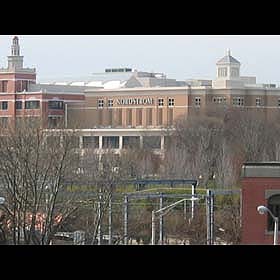
Introduction
The construction of the Providence Place Mall was a bold move to revitalize the urban center of the city, create new jobs, and generate tax revenue. The debate that surrounded the development of the mall formed the structure as it exists today. Opened in 1999, the multi-level complex is the centerpiece of the Capital Center Development District meant to enlarge and invigorate Providence.
Mall promoters promised jobs, tax revenues, and the renewal of downtown Providence as a shopping destination. Indeed, Providence did not have a concentration of stores like Nordstrom, Lord and Taylor, The Pottery Barn, Williams-Sonoma, and Eddie Bauer before the opening of the mall. Critics worried that the mall would invite shoppers and pedestrians into the city and then isolate shoppers within its walls.
The largest building in the state, the $500 million mall was a public and private venture in which taxpayers contribute to the mall, allowing the developer to retain the first $6 million in sales tax receipts for twenty years, and the city of Providence would forgive the property tax for 20 years.
The Idea of a Suburban Mall in the City
The introduction of the typically suburban shopping complex to the urban landscape of Providence required architects to fuse the urban and suburban retail shopping models. Usually a sprawling mall is surrounded by acres of parking lots, has only one or two levels. In contrast, the urban shopping environment usually consists of storefronts on a street with pedestrian traffic. The site of the mall is thirteen acres, and so the parking had to be brought into the structure of the mall itself. Additionally, there are seven main floors of retails stores, restaurants, and kiosks and entertainment venues.
Different Voices in the Design
The design of the seven-floor building itself embodies the forces exerted during its creation. The Capital Center Commission envisioned a space that would invite visitors to enter the city and spend time and money there. The developer, Commonwealth Development Group, hoped to build a large profitable mall. Individual retailers strove to create spaces that would maximize sales per square foot. Additionally, individual residents and organizations like the Providence Preservation Society wanted to influence the aesthetics and practicalities of the design. Multiple architects worked on the designs and on individual stores. The struggles of these sometimes contradictory voices physically manifested themselves in the design of the mall.
Leslie A. Gardner, a banker, chaired the Capital Center Commission, which coordinated the interface of the developers, the perservationists, and the public during the design process. The Providence Preservation Society, where Gardner had been president, wanted to ensure that the building retain an urban character, and that the facade would be divided into harmonious sections that might imitate a city block.
Adrian Smith of Skidmore, Owings & Merrill was the original architect of the building that straddles the Woonasquatucket River and train tracks entering the city. A large dome, echoing the shape of the dome on the capitol, was to sit on top of the building. Friedrich St. Florian, a local architect and Rhode Island School of Design professor, drew the final design. St. Florian replaced Smith's dome with a long glass vault, called the "Wintergarden" above the food court and river.
Because Providence Place Mall is an urban shopping center, designers wanted to make it as penetrable as possible. Along Francis Street, restaurants and stores face the street at circulation level. However, the anchor stores like Nordstrom refused to have a public entrance from the street in the store or to place windows in their façade. In fact, blinded windows block viewers from seeing what would be exceptional views of the capital and the cityscape. In this way the building sets up exterior barriers, resisting complete interface with the city. Before the mall was built the land once housed a 19th-century prison, and then buildings of the University of Rhode Island Department of Continuing Education.
Assessment of Providence Place Mall
Serious circulation problems plague the parking structure of the building as well as the flow of pedestrian traffic through the mall. Since the building sits on both sides of the river, shoppers must know that there are two separate garages. Additionally, the elevators and escalators that bring visitors to the upper levels of the mall are only at the two ends of the mall, blocking people from easily going from one store to another one below it. Elevators are difficult to find, as the designers clearly preferred to expose the visitor to more stores. Although Lord & Taylor, one of the three anchor stores is leaving the mall in early 2004, five new stores have signed leases and the mall remains at 98% capacity.
The many, sometimes contradictory interests of city planners, developers, preservationists, individuals, architects, and retail stores created a building that has indeed supplied the city with new jobs and tax revenues, but this structure is sometimes difficult to navigate, and does not fully invite visitors to experience the city visually as it might. Greater views of the city from within the mall, or even a roof-top cafe might have given visitors more opportunities to interface with the city in addition to the merchandise at the mall.
Sources
Tooher, Nora Lockwood, "'An Exceedingly Important Milestone' Debate yields to harmony with approval of mall design" Providence Journal-Bulletin July 11, 1997 p A.01.
"As building begins on mall, talking continues 'There is room for improvement' Mall construction gets go-ahead from Capital Center Commission" Providence Journal-Bulletin May 30, 1997. p. A.1.
"Design Debate: Leslie A. Gardner is caught between the mall's developers and the preservationists" Providence Journal-Bulletin May 18, 1997. p. F.01.
"Who gets final say on mall design?" Providence Journal-Bulletin Apr. 29, 1997 p. E.1.
Van Siclen, Bill, "Design for Providence's urban mall is as good as it gets" Providence Journal-Bulletin Jul 11, 1997 p A.13.
"Rivers were moved, a mall was built, a downtown reborn. Will the Renaissance continue?" Providence Journal May 21, 2000, p. A.1
West, Darrell and Marion Orr, "Assessing the Providence Place Mall" Brown Policy Reports, June 2000.
"No shopping crisis" Providence Journal editorial Sept 22, 2003, p A.12.












